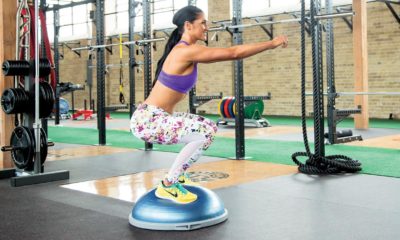Fitness
The Pros And Cons Of Working Out At Home
Gone are the days where you could only get fit if you owned a gym membership. Most people’s lives aren’t confined to the 9-5 model that was once so popular and with the rise in shift work, many are opting to get their sweat on from the comfort of their home.
But, is working out at home better? We’ve decided to break down some of the pros and cons for you so you can decide whether ditching the gym is worth it.
Pro: Open whenever you want
Unlike your gym, which closes at night and can be shut around the holidays, your living room is open when it’s convenient for you. Even with the rising popularity of 24 hour, low-cost gyms, they haven’t quite done a Starbucks, so they’re not on every corner, yet
Not everyone is on the 9-5 schedule that these establishments are built around. For the parents, shift workers or night owls, working out from the comfort of their own home may be the perfect solution.
Pro: No comparisons
For newbies, nothing can be more intimidating than being surrounded by experts. Being in your space, without the distractions of advanced workouts and grunting, you’re free to concentrate on your own technique and progress.
While there can be benefits to aspiring to other gym goers, sticking to your living room, especially in the beginning, can keep you focused. You’re also less likely to quit at the sign of someone deadlifting twice your weight.
Pro: It’s free
One of the most appealing aspects of skipping the gym in favor of at home workouts is the low cost. You don’t have to pay for travel or a membership which can cost on average, $40-$50 per month. You’re also not expected to fork out any initial fees that many gyms require before you can even start resenting the treadmill.
You can also use many items around your house to help you work out and the yoga mat you bought years ago might finally see the light of day.
Pro: Everything is on your terms
No queues, sweaty equipment or loud club music. You can create your own workout area that makes you feel motivated and raring to go. You can create a space that suits your needs without the hassle of strangers messing up your flow.
We all have our pet peeves at the gym, but this way you can control the environment and there will be no excuses like: ‘I can’t do weights because there aren’t any available.’
Pro: YouTube: The personal trainer
You no longer have to take out a small loan to pay for personalized workouts. YouTube has hundreds of thousands of videos all in the name of health and fitness. You can find a workout for pretty much anything and the pause button means you can go at your speed and don’t have to ask your instructor to repeat the instruction for a third time. Oh, and as long as you have an internet connection – it’s free!
– RELATED: A Beginner’s Guide To Home Bodyweight Workouts –
Cons: Lack of a spotter
If you look to invest in equipment like a bench, you won’t have the luxury of being able to ask someone to spot you. This can be dangerous so, if you’re working out from home, ask for a friend or family member to be your spot to ensure you’re being as safe as possible.
Cons: Motivation
It’s no secret that working out on your own doesn’t always lead to consistent, hard-core training. Having a gym buddy or some accountability ensures you don’t give up and opt for a lazy day instead. You can always try and find a partner to work out with in your new home workout space, but if not, this can be a major deal breaker when it comes to the gym vs. living room debate.
Cons: Equipment cost
You may not have to fork out for a membership every month, but even the most basic equipment doesn’t come cheap. If you want to keep improving your fitness you might need to invest in additional weights or even cardio equipment such as a treadmill or bike.
It’s not always necessary, as many people enjoy bodyweight workouts and doing HIIT routines to replace the elliptical. It depends what you enjoy and what works for you, but if you enjoy your machines, it can get pricy.
For more workout hints and tips, sign up to the TRAIN for HER newsletter.






















